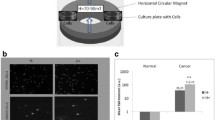Abstract
Magnetic isotope effect controls enzymatic DNA synthesis and strongly, by 2–3 times, suppresses catalytic activity of polymerases and increases even more strongly, by 20–50 times, the mortality of cancer cells. Catalyzing ions 25Mg2+, 43Ca2+, and 67Zn2+ carrying magnetic nuclei are shown to efficiently kill cancer cells. The advantage of these ions for practical medicine is that being injected in blood they are captured selectively and almost exclusively by cancer cells inducing their death. The healthy cells capture these ions much less efficiently (perhaps due to the lower penetrability of their membranes) and are not vulnerable to these ions in comparison with cancer cells. Of course, penetrability of cells is identical for magnetic and nonmagnetic ions, but only the former kill cancer cells.
Similar content being viewed by others
References
A. L Buchachenko and G. A. Nikiforov, Dokl. Akad. Nauk SSSR 228, 379 (1976).
A. L Buchachenko, Chem. Rev. 95, 2507 (1995).
A. L Buchachenko, J. Phys. Chem. A 105, 9995 (2001)
A. L. Buchachenko, J. Phys. Chem. B 117, 2231 (2013).
A. L Buchachenko, Magnetic Isotope Effect in Chemistry and Biochemistry (Nova Science, New York, 2009).
A. L. Buchachenko and R. G. Lawler, Acc. Chem. Res. 50, 877 (2017).
A. L. Buchachenko, D. A. Kuznetsov, and N. N. Breslavskaya, Chem. Rev. 112, 2042 (2012)
A. L. Buchachenko, D. A. Kuznetsov, and N. N. Breslavskaya, J. Phys. Chem. B 114, 2287 (2010).
A. L. Buchachenko and D. A. Kuznetsov, J. Phys. Chem. Biophys. 4, 142 (2014).
A. L Buchachenko, A. P. Orlov, D. A. Kuznetsov, and N. N. Breslavskaya, Nucl. Acids Res. 41, 8300 (2013).
A. L. Buchachenko, A. P. Orlov, D. A Kuznetsov, and N. N. Breslavskaya, Chem. Phys. Lett. 586, 138 (2013)
M. A. Orlova, E. Y. Osipova, and S. A. Roumiantsev, Brit. J. Med. Med. Res. 2, 21 (2012).
A. A. Bukhvostov, A. A. Shatalov, A. L. Buchachenko, and D. A. Kuznetsov, Pharm. Lett. 18 (2013).
A. A. Bukhvostov, J. K. Napolov, A. L. Buchachenko, and D. A. Kuznetsov, Brit. J. Pharmacol. Toxicol. 5, 35 (2014).
T. A. Steitz, J. Biol. Chem. 274, 1739 (1999).
M. D. Bojin and T. A. Schlick, J. Phys. Chem. B 111, 11244 (2007).
I. L. Alberts, Y. Wang, and T. Schlick, J. Am. Chem. Soc. 129, 11100 (2007).
N. Amirshahi, R. Alyautdin., S. Sarkar, S. Rezayat, M. Orlova, I. Trushkov, A. Buchachenko, and D. Kuznetsov, Int. J. Nanosci. 7, 113 (2008).
S. Rezayat, S. Boushehri, B. Salmanian, A. Omidvari, S. Tarighat, S. Esmaeli, S. Sarkar, N. Amirshahi, R. Alyautdin, M. Orlova, I. Trushkov, A. Buchachenko, and D. Kuznetsov, Eur. J. Med. Chem. 44, 1554 (2009).
N. Amirshahi, S. Rezayat, S. Boushehri, B. Salmanian, A. Omidvari, S. Tarighat, S. Esmaeli, S. Sarkar, R. Alyautdin, M. Orlova, I. Trushkov, A. Buchachenko, and D. Kuznetsov, Arch. Med. Res. 39, 549 (2008).
A. A. Bukhvostov, A. S. Dvornikov, K. V. Ermakov, and D. A. Kuznetsov, Arch. Cancer Res. 5, 158 (2017).
A. A. Bukhvostov, A. S. Dvornikov, K.V. Ermakov, P. B. Kurapov, and D. A. Kuznetsov, Acta Med. 60, 93 (2017).
A. A. Bukhvostov, A. S. Dvornikov, K. V. Ermakov, P. B. Kurapov, and D. A. Kuznetsov, Int. J. Cancer Biol. Clin. Oncol. 1.1, 34 (2017).
A. L. Buchachenko, Bioelectromagnetics 37, 1 (2016).
A. L. Buchachenko, Magneto-Biology and Medicine (Nova Science, New York, 2014).
Author information
Authors and Affiliations
Corresponding author
Additional information
The article is published in the original.
Rights and permissions
About this article
Cite this article
Kuznetsov, D.A., Buchachenko, A.L. Nuclear Magnetic Ions of Magnesium, Calcium, and Zinc as a Powerful and Universal Means for Killing Cancer Cells. Russ. J. Phys. Chem. B 12, 690–694 (2018). https://doi.org/10.1134/S1990793118040267
Published:
Issue Date:
DOI: https://doi.org/10.1134/S1990793118040267




